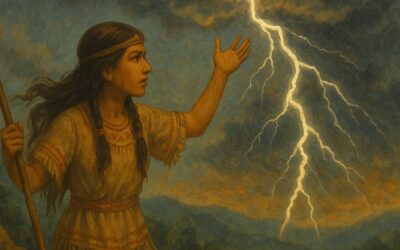- Introduction
- William Tell, Man or Myth? Separating Fact from Fiction
- Introduction
- Origins of the William Tell Legend
- Evidence for William Tell’s Existence
- Separating Fact from Fiction
- Conclusion
- Plus Discussion Questions
- Q — What are the origins of the William Tell legend, and how has the story evolved over time?
- Q — What evidence is there to suggest that William Tell may have actually existed, and how reliable is this evidence?
- Q — What are some of the key differences between the earliest versions of the William Tell legend and the later, more embellished versions?
- Q — To what extent do you think the story of William Tell reflects real historical events, and to what extent is it a product of myth and legend?
- Q — How has the legend of William Tell influenced Swiss culture and national identity, and why do you think this figure continues to resonate with people today?
Introduction
Explore the origins of the William Tell legend and separate fact from fiction in Swiss folklore. Learn about the evidence for his existence, the embellishments to his story, and the enduring legacy of this legendary figure in Swiss culture.
William Tell, Man or Myth? Separating Fact from Fiction
Introduction
William Tell is a legendary figure in Swiss folklore who is famous for his incredible archery skills and his act of defiance against the tyrannical rule of the Habsburgs. But as with many legendary figures, the lines between fact and fiction have become blurred over time. In this blog post, we will explore the origins of the William Tell legend, examine the evidence for his existence, and separate the facts from the fiction.
Origins of the William Tell Legend
The story of William Tell first appeared in a 15th-century Swiss chronicle called the White Book of Sarnen. According to the legend, William Tell was a skilled archer who was forced by the Habsburgs to shoot an apple off his son’s head as a punishment for refusing to bow down to a Habsburg hat. Tell succeeded in the task, and then went on to lead a successful rebellion against the Habsburgs, culminating in the formation of the Swiss Confederacy.
Evidence for William Tell’s Existence
Despite being a legendary figure, there is some evidence to suggest that William Tell may have actually existed. The White Book of Sarnen is not the only historical document to mention him. The Tellenlied, a 16th-century ballad, also tells the story of William Tell and was widely popular in Switzerland at the time. In addition, there are numerous historical documents that mention a man named William Tell or Wilhelm Tell who was involved in the early Swiss struggle for independence.
One of the most compelling pieces of evidence for William Tell’s existence is a 16th-century painting by the Swiss artist Ernst Stückelberg, which depicts Tell shooting the apple off his son’s head. The painting is believed to be based on an earlier 15th-century painting that has since been lost, and it suggests that the legend of William Tell was well-known and widely accepted in Switzerland at the time.
Separating Fact from Fiction
Despite the evidence for his existence, it is clear that much of the story of William Tell has been embellished and mythologized over time. For example, the idea that Tell was forced to shoot an apple off his son’s head as a punishment for refusing to bow down to a Habsburg hat is likely a later addition to the story. In the earliest versions of the legend, there is no mention of a hat, and Tell’s motivation for shooting the apple is simply to prove his marksmanship.
Similarly, the idea that William Tell played a major role in the formation of the Swiss Confederacy is likely an exaggeration. While it is true that Tell is sometimes portrayed as a leader of the rebellion against the Habsburgs, it is more likely that he was simply one of many Swiss patriots who fought for independence.
Conclusion
In the end, the story of William Tell is a fascinating example of how legends and myths can develop over time. While there is evidence to suggest that a man named William Tell may have actually existed, much of the story that has been passed down to us is likely a mixture of fact and fiction. Nevertheless, the legend of William Tell continues to capture the imagination of people around the world, and his story serves as a symbol of Swiss independence and defiance against tyranny.
Whether William Tell was a man or a myth, his legacy lives on to this day, inspiring generations of Swiss patriots and freedom fighters. So the next time you hear the story of William Tell, remember that there may be more to it than meets the eye, and take a moment to appreciate the complex history and mythology that have made him such an enduring figure in Swiss culture.
Plus Discussion Questions
Q — What are the origins of the William Tell legend, and how has the story evolved over time?
The William Tell legend originated in a 15th-century Swiss chronicle called the White Book of Sarnen. The story goes that William Tell, a skilled archer, was forced by the Habsburgs to shoot an apple off his son’s head as punishment for refusing to bow down to a Habsburg hat. Tell succeeded in the task and went on to lead a successful rebellion against the Habsburgs, culminating in the formation of the Swiss Confederacy.
Over time, the story of William Tell has evolved and become embellished. For example, the idea that Tell was forced to shoot an apple off his son’s head as a punishment for refusing to bow down to a Habsburg hat is likely a later addition to the story. In the earliest versions of the legend, there is no mention of a hat, and Tell’s motivation for shooting the apple is simply to prove his marksmanship. Similarly, the idea that William Tell played a major role in the formation of the Swiss Confederacy is likely an exaggeration. While it is true that Tell is sometimes portrayed as a leader of the rebellion against the Habsburgs, it is more likely that he was simply one of many Swiss patriots who fought for independence.
Q — What evidence is there to suggest that William Tell may have actually existed, and how reliable is this evidence?
While William Tell is primarily considered a legendary figure, there is some evidence to suggest that he may have actually existed. The White Book of Sarnen is not the only historical document to mention him. The Tellenlied, a 16th-century ballad, also tells the story of William Tell and was widely popular in Switzerland at the time. In addition, there are numerous historical documents that mention a man named William Tell or Wilhelm Tell who was involved in the early Swiss struggle for independence.
One of the most compelling pieces of evidence for William Tell’s existence is a 16th-century painting by the Swiss artist Ernst Stückelberg, which depicts Tell shooting the apple off his son’s head. The painting is believed to be based on an earlier 15th-century painting that has since been lost, and it suggests that the legend of William Tell was well-known and widely accepted in Switzerland at the time.
However, the reliability of this evidence is subject to debate. Some historians argue that the historical documents mentioning William Tell are too sparse and unreliable to prove his existence. Others argue that the William Tell legend is a combination of multiple historical figures and events, rather than being based on a single individual. Overall, the evidence for William Tell’s existence is inconclusive, and the legend remains primarily a product of myth and folklore.
Q — What are some of the key differences between the earliest versions of the William Tell legend and the later, more embellished versions?
One of the key differences between the earliest versions of the William Tell legend and the later, more embellished versions is the motivation behind Tell’s archery feat. In the earliest versions, there is no mention of a hat, and Tell’s motivation for shooting the apple is simply to prove his marksmanship. Later versions of the story add the detail that Tell was forced to shoot the apple off his son’s head as punishment for refusing to bow down to a Habsburg hat.
Another key difference is the role that William Tell played in the formation of the Swiss Confederacy. While later versions of the legend portray Tell as a leader of the rebellion against the Habsburgs, it is more likely that he was simply one of many Swiss patriots who fought for independence.
In addition, the earliest versions of the legend focus more on the act of archery itself, while later versions tend to emphasize the political and historical significance of the story. Later versions also tend to be more dramatic and embellished, featuring additional characters, plot twists, and details that were not present in the original versions.
Overall, the differences between the earliest and later versions of the William Tell legend reflect the ways in which stories and legends evolve over time, as they are passed down through different cultures and historical periods.
Q — To what extent do you think the story of William Tell reflects real historical events, and to what extent is it a product of myth and legend?
The story of William Tell likely reflects real historical events to some extent, but it is also undoubtedly a product of myth and legend. While there is some evidence to suggest that a man named William Tell may have actually existed, many details of the story, such as the apple-shooting incident and Tell’s role in the formation of the Swiss Confederacy, are likely embellishments and exaggerations.
However, it is also possible that the William Tell legend is based on a combination of historical figures and events, rather than being based on a single individual. The legend may have developed over time as a way for the Swiss to commemorate their struggle for independence and their resistance against the Habsburgs.
Overall, the story of William Tell can be seen as a mixture of fact and fiction, reflecting the complex interplay between history and mythology. While the details of the story may be difficult to verify, its enduring popularity and cultural significance suggest that it continues to hold meaning and value for people today.
Q — How has the legend of William Tell influenced Swiss culture and national identity, and why do you think this figure continues to resonate with people today?
The legend of William Tell has had a significant influence on Swiss culture and national identity. As a symbol of Swiss resistance against foreign rule and tyranny, William Tell has come to represent the core values of Swiss independence, freedom, and self-determination. The story of William Tell has been taught in Swiss schools for generations and is a prominent part of Swiss cultural heritage.
The figure of William Tell continues to resonate with people today for a number of reasons. First, the story of William Tell represents the triumph of the underdog against a more powerful oppressor, which is a theme that continues to inspire people around the world. Second, the story highlights the importance of individual freedom and autonomy, which are values that are highly prized in modern society.
In addition, the legend of William Tell has been adapted and reinterpreted in a variety of ways over the centuries, which has helped to keep the story fresh and relevant. Today, William Tell is celebrated in a variety of media, including literature, film, and music, which helps to keep his story alive and relevant to new generations.
Overall, the legend of William Tell has had a profound impact on Swiss culture and national identity, and it continues to inspire people around the world with its themes of resistance, freedom, and individual autonomy.










0 Comments